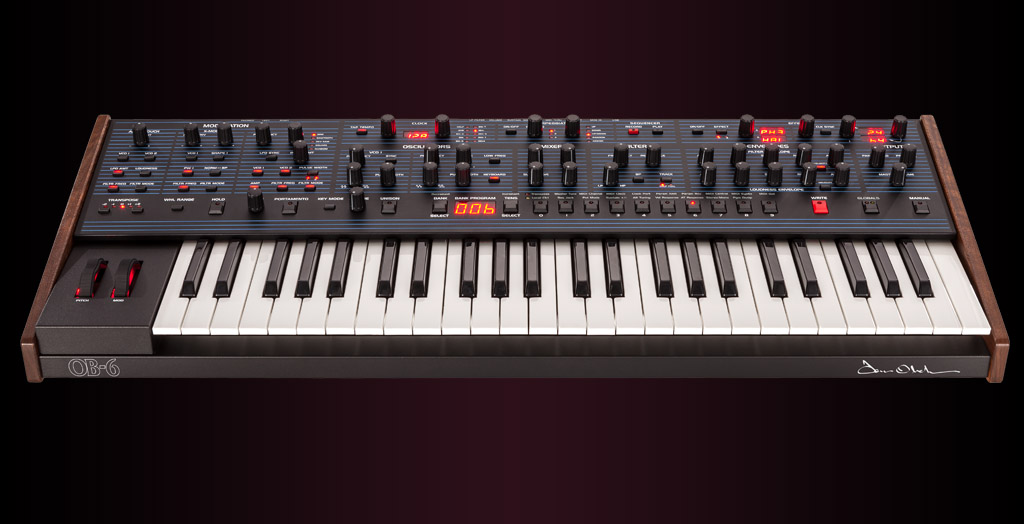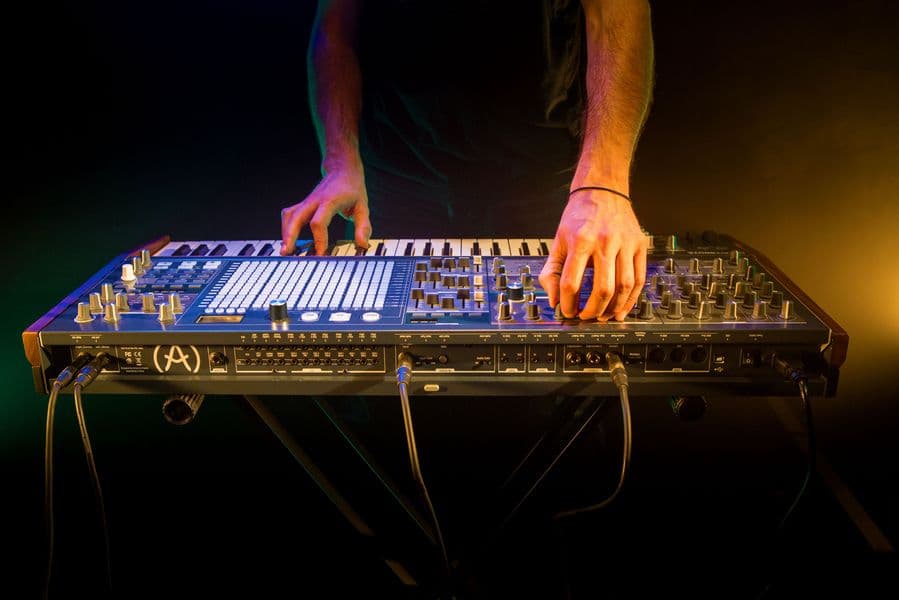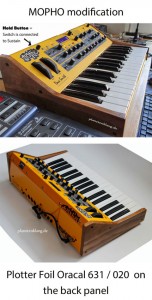Durch die Zusammenarbeit Tom Oberheim und Dave Smith ist der neue OB6 Synthesizer auf den Markt gekommen!

OB-6 Specifications
OSCILLATORS
- Two discrete VCOs per voice
- Continuously variable wave shape (sawtooth and variable-width pulse, plus triangle on oscillator 2) per oscillator
- Pulse width per oscillator
- Hard sync: oscillator 1 syncs to oscillator 2
- Square wave sub-octave generator (oscillator 1) per voice
- Low frequency mode (oscillator 2)
- Keyboard tracking on/off (oscillator 2)
- Oscillator detune amount for increased tuning instability, from subtle to extreme
MIXER
- Oscillator 1 amount
- Oscillator 1 sub-octave amount
- Oscillator 2 amount
- White noise amount
STATE-VARIABLE FILTER
- Two-pole, resonant, filter per voice with low-pass, high-pass, band-pass, and notch functionality inspired by the original Oberheim SEM filter
- Bi-polar filter envelope amount
- Velocity modulation of envelope amount
- Keyboard tracking: off, half, full
FILTER ENVELOPE
- Four-stage (ADSR) envelope generator
- Velocity modulation of envelope amount
AMPLIFIER ENVELOPE
- Four-stage (ADSR) envelope generator
- Velocity modulation of envelope amount
LOW FREQUENCY OSCILLATOR
- Five wave shapes: triangle, sawtooth, reverse sawtooth, square, and random (sample and hold)
- Clock sync (internal or external MIDI clock)
- Initial amount
- Mod destinations: oscillator 1 frequency, oscillator 2 frequency, oscillator 1 and 2 pulse width, filter cutoff, filter mode
X-MOD
- Sources: filter envelope (bi-polar) and oscillator 2 (bi-polar)
- Destinations: oscillator 1 frequency, oscillator 1 shape, oscillator 1 pulse width, filter cutoff, filter mode
AFTERTOUCH
- Source: channel (mono) aftertouch with bi-polar amount
- Destinations: oscillator 1 frequency, oscillator 2 frequency, LFO amount, amplifier envelope amount, filter envelope amount
CLOCK
- Master clock with tap tempo
- BPM control and display
- MIDI clock sync
ARPEGGIATOR
- Selectable note value: 16th note, 8th note triplet, 8th note, dotted 8th note, quarter note
- One, two, or three octave range
- Up, down, up/down, random, and assign modes
SEQUENCER
- Polyphonic step sequencer with up to 64 steps and rests
EFFECTS
- Stereo analog distortion
- Dual, 24-bit, 48 kHz digital effects, including: reverb (room, hall, plate, spring), delay (full bandwidth digital delay and emulated bucket brigade and tape delays), chorus, flanger, phase shifters, and ring modulator
- Delay sync
- True bypass maintains fully analog signal path when digital effects are off
PERFORMANCE CONTROLS
- Full-sized, semi-weighted, 4-octave keyboard with velocity and aftertouch
- Backlit pitch and mod wheels
- Spring-loaded pitch wheel with selectable range per program (1 to 12 semitones up and down)
- Transpose controls for an 8-octave range
- Hold switch latches held notes on
- Polyphonic portamento
- Unison (monophonic) mode with configurable voice count, from one to all six voices, chord memory, and key modes
- Manual switch: when off, the front panel is live; what you see is what you hear
PATCH MEMORY
- 500 user and 500 factory programs in 10 banks of 100 programs each
- Direct program access, including single-button access to the current set of 10 programs
IN/OUT
- Left/mono and right audio outputs (2 x 1/4” phone jack)
- Headphone output (stereo, 1/4” phone jack)
- MIDI in, out, and thru ports
- USB for bidirectional MIDI communication
- Filter cutoff expression pedal input
- Volume expression pedal input
- Sustain footswitch input
- Sequencer start/stop footswitch input
POWER
- IEC AC power inlet for internal power supply
- Operates worldwide on voltages between 100 and 240 volts at 50 to 60 Hz; 30 watts maximum power consumption
PHYSICAL SPECS
- 32” L x 12.7” W x 4.6″ H (81.3 cm x 32.3 cm x 11.7 cm)
- 0 lbs (9.5 kg)
Zur Hersteller Seite (es öffnet sich ein neues Browserfenster)



